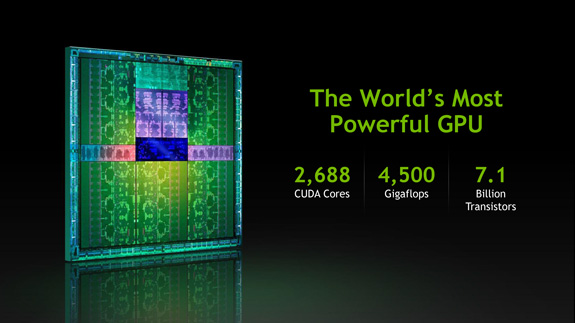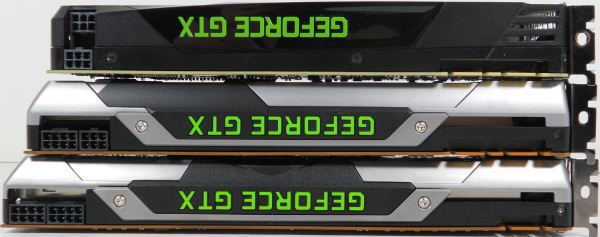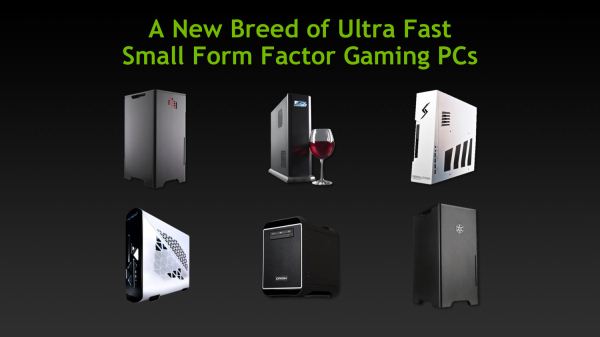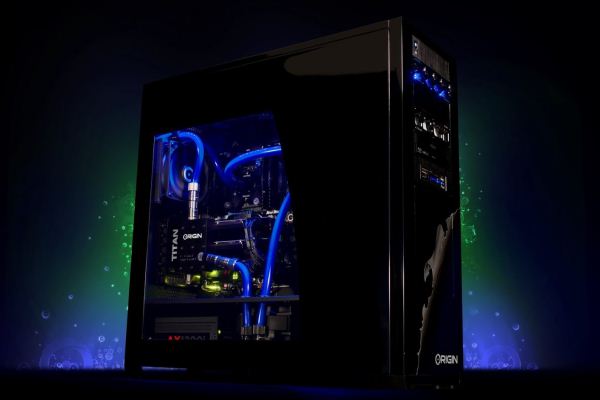NVIDIA's GeForce GTX Titan, Part 1: Titan For Gaming, Titan For Compute
by Ryan Smith on February 19, 2013 9:01 AM ESTWho’s Titan For, Anyhow?
Having established performance expectations, let’s talk about where Titan fits into NVIDIA’s product stack. First and foremost, though Titan is most certainly geared in part as a gaming video card (and that’s largely how we’ll be looking at it), that’s not the only role it serves. Titan is also going to be NVIDIA’s entry-level compute card. We’ll dive more into why that is in a bit in our feature breakdown, but the biggest factor is that for the first time on any consumer-level NVIDIA card, double precision (FP64) performance is uncapped. That means 1/3 FP32 performance, or roughly 1.3TFLOPS theoretical FP64 performance. NVIDIA has taken other liberties to keep from this being treated as a cheap Tesla K20, but for lighter workloads it should fit the bill.
As compared to the server and high-end workstation market that Tesla carves out, NVIDIA will be targeting the compute side of Titan towards researchers, engineers, developers, and others who need access to (relatively) cheap FP64 performance, and don’t need the scalability or reliability that Tesla brings. To that end Titan essentially stands alone in NVIDIA’s product stack; the next thing next to a FP64-constrained consumer card is the much more expensive Tesla K20.

Far more complex will be the gaming situation. Titan will not be pushing anything down in NVIDIA’s product stack, rather NVIDIA’s product stack will be growing up to accompany Titan. Like the GTX 690, NVIDIA is going to position Titan as a premium/luxury product, releasing it at the same $999 price point. GTX 690 itself will continue to exist at the same $999 price point, meanwhile GTX 680 will continue at its current price point of roughly $450.
Continuing the GTX 690 analogies, Titan will not only be sharing in GTX 690’s price point, but also in its design principles and distribution. This means Titan is a well-built card with its housing composed primarily of metals, with the same kind of luxury finish as the GTX 690. On the distribution side of things Asus and EVGA are once again NVIDIA’s exclusive partners for North America, and they will essentially be distributing reference Titan cards. In time we will see some specialized variation, with water-cooling in particular being an obvious route for EVGA to go. Factory overclocks are also on the table.
With the above in mind, it goes without saying that while GTX 690 had some historical precedence in its price, the same cannot be said for Titan. The price of NVIDIA’s top-tier single-GPU video cards hovered around $500 for the GeForce 400/500 series, and while they attempted to launch at $650 for the GTX 280, the launch of the Radeon HD 4870 quickly brought that price down to earth. As such this will be the most expensive single-GPU product out of NVIDIA yet.

Top To Bottom: GTX 680, GTX Titan, GTX 690
Ultimately NVIDIA is not even going to try to compete on a price-performance basis with Titan. There are a number of potential reasons for this – ranging from the competitive landscape to yields to needs for GK110 GPUs elsewhere within NVIDIA – and all of those reasons are probably true to some extent. Regardless, NVIDIA believes that like the GTX 690 they can sell Titan as a luxury product, and hence $999. The GTX 680 and below will compose NVIDIA’s more traditional price-performance competitive fare.
As to be expected from such a price, NVIDIA’s marketing department will be handling Titan in a similar fashion as they did GTX 690. This not only includes reiterating the fact that Titan is intended to be a luxury product, but also focusing on markets where luxury products are accepted, and where Titan in particular makes sense.
Perhaps not surprisingly, with $999 video cards the makeup of consumers shifts away from both traditional big-box OEMs and DIY builders, and towards boutique builders. Boutique builders are essentially already in the business of providing luxury computers, offering an outlet for luxury buyers who need not spend their time building their own computer, and want something of higher quality than what the typical OEM provides. As such while Titan will be sold on the open market just as like any other card, NVIDIA tells us that they expect a lot of those buyers are going to be the boutiques.
For Titan in particular, NVIDIA is going to be focusing on two boutique computer concepts, reflecting the blower design of Titan as opposed to the front/back exhausting design of the GTX 690. The first concept will be SFF PCs, where blowers are a necessity due to a lack of space (and often, a lack of heavy sound dampening), and where such cards can draw fresh air in from outside the chassis.
On the other end of the spectrum will be the ultra-enthusiast market where one Titan isn’t enough, and even two may come up short. Again thanks to the fact that it’s a blower, Titan can easily be fit in an ATX motherboard for tri-SLI operation, which NVIDIA envisions not just as the ultimate gaming computer, but the ultimate NV/3D Surround computer in particular. Multi-monitor gaming with graphically intensive games can quickly nullify the performance of even a single Titan card, so tri-SLI is NVIDIA’s solution to driving three monitors as well as one Titan can drive one monitor. At the same time however, NVIDIA intends to showcase that a tri-SLI system doesn’t need to be loud, despite the cramped conditions and despite the 750W+ that 3 Titans will pull, thanks to the high quality construction of the cards. Tri-SLI has been possible for a number of years, but NVIDIA believes with Titan in particular they have a solid grip on the heat and noise concerns it typically comes with.
To that end, as part of the Titan launch NVIDIA has shipped out a number of boutique systems in either a SFF or tri-SLI full tower configuration to reviewers, in order to show off their usage concepts in completed and well-constructed systems. Anand received a SFF Tiki from Falcon Northwest, while I have received a tri-SLI equipped Genesis from Origin PC. Like Titan itself we can’t talk about the performance of these systems, but we’ll be able to go into greater detail on Thursday when the complete NDA lifts. In the meantime we’ve been able to post a few impressions, which we’ve put up on their respective articles.
Moving on, with a $999 launch price NVIDIA’s competition will be rather limited. The GTX 690 is essentially a companion product; NVIDIA’s customers can either get the most powerful single-GPU card NVIDIA offers in a blower design, or an alternative design composed of two lesser GPUs in SLI, in a front and rear exhausting design. The GTX 690 will be the faster card, but at a higher TDP and with the general drawbacks of SLI. On the other hand Titan will be the more consistent card, the lower TDP card, the easier to cool card, but also the slower card. Meanwhile though it’s not a singular product, the GTX 680 SLI will also be another option, offering higher performance, higher TDP, more noise, and a cheaper price tag of around $900.
As for AMD, with their fastest single-GPU video card being the 7970 GHz Edition, offering performance closer to the GTX 680 than Titan, Titan essentially sits in a class of its own on the single-GPU front. AMD’s competition for Titan will be the 7970GE in CrossFire, and then the officially unofficial 7990 family, composed of the air-cooled PowerColor 7990, and the closed loop water-cooled Asus Ares II. But with NVIDIA keeping GTX 690 around, these are probably closer competitors to the multi-GPU 690 than they are the single-GPU Titan.
Finally, let’s talk launch availability. By scheduling the launch of Titan during the Chinese New Year, NVIDIA has essentially guaranteed this is a delayed availability product. Widespread availability is expected on the 25th, though cards may start popping up a couple of days earlier. NVIDIA hasn’t gone into depth for launch quantities, but they did specifically shoot down the 10,000 card rumor; this won’t be a limited run product and we don’t have any reason at this time to believe this will be much different from the GTX 690’s launch (tight at first, but available and increasingly plentiful).
| February 2013 GPU Pricing Comparison | |||||
| AMD | Price | NVIDIA | |||
| $1000 | GeForce GTX Titan/690 | ||||
| (Unofficial) Radeon HD 7990 | $900 | ||||
| Radeon HD 7970 GHz Edition | $450 | GeForce GTX 680 | |||
| Radeon HD 7970 | $390 | ||||
| $350 | GeForce GTX 670 | ||||
| Radeon HD 7950 | $300 | ||||












157 Comments
View All Comments
bigboxes - Tuesday, February 19, 2013 - link
This is Wreckage we're talking about. He's trolling. Nothing to see here. Move along.chizow - Tuesday, February 19, 2013 - link
I agree with his title, that AMD is at fault at the start of all of this, but not necessarily with the rest of his reasonings. Judging from your last paragraph, you probably agree to some degree as well.This all started with AMD's pricing of the 7970, plain and simple. $550 for a card that didn't come anywhere close to justifying the price against the last-gen GTX 580, a good card but completely underwhelming in that flagship slot.
The 7970 pricing allowed Nvidia to:
1) price their mid-range ASIC, GK104, at flagship SKU position
2) undercut AMD to boot, making them look like saints at the time and
3) delay the launch of their true flagship SKU, GK100/110 nearly a full year
4) Jack up the prices of the GK110 as an ultra-premium part.
I saw #4 occurring well over a year ago, which was my biggest concern over the whole 7970 pricing and GK104 product placement fiasco, but I had no idea Nvidia would be so usurous as to charge $1k for it. I was expecting $750-800....$1k....Nvidia can go whistle.
But yes, long story short, Nvidia's greed got us here, but AMD definitely started it all with the 7970 pricing. None of this happens if AMD prices the 7970 in-line with their previous high-end in the $380-$420 range.
TheJian - Wednesday, February 20, 2013 - link
You realize you're dogging amd for pricing when they lost 1.18B for the year correct? Seriously you guys, how are you all not understanding they don't charge ENOUGH for anything they sell? They had to lay of 30% of the workforce, because they don't make any money on your ridiculous pricing. Your idea of pricing is KILLING AMD. It wasn't enough they laid of 30%, lost their fabs, etc...You want AMD to keep losing money by pricing this crap below what they need to survive? This is the same reason they lost the cpu war. They charged less for their chips for the whole 3yrs they were beating Intel's P4/presHOT etc to death in benchmarks...NV isn't charging too much, AMD is charging too LITTLE.AMD has lost 3-4B over the last 10yrs. This means ONE thing. They are not charging you enough to stay in business.
This is not complicated. I'm not asking you guys to do calculus here or something. If I run up X bills to make product Y, and after selling Y can't pay X I need to charge more than I am now or go bankrupt.
Nvidia is greedy because they aren't going to go out of business? Without Intel's money they are making 1/2 what they did 5yrs ago. I think they should charge more, but this is NOT gouging or they'd be making some GOUGING like profits correct? I guess none of you will be happy until they are both out of business...LOL
chizow - Wednesday, February 20, 2013 - link
1st of all, AMD as a whole lost money, AMD's GPU division (formerly ATI) has consistently operated at a small level of profit. So comparing GPU pricing/profits impact on their overall business is obviously going to be lost in the sea of red ink on AMD's P&L statement.Secondly, the massive losses and devaluation of AMD has nothing to do with their GPU pricing, as stated, the GPU division has consistently turned a small profit. The problem is the fact AMD paid $6B for ATI 7 years ago. They paid way too much, most sane observers realized that 7 years ago and over the past 5-6 years it's become more obvious. The former ATI's revenue and profits did not justify the $6B price tag and as a result, AMD was *FORCED* to write down their assets as there were some obvious valuation issues related to the ATI acquisition.
Thirdly, AMD has said this very month that sales of their 7970/GHz GPUs in January 2013 alone exceeded sales of those cards in the previous *TWELVE MONTHS* prior. What does that tell you? It means their previous price points that steadily dropped from $550>500>$450 were more than the market was willing to bear given the product's price:performance relative to previous products and the competition. Only after they settled in on that $380/$420 range for the 7970/GHz edition along with a very nice game bundle did they start moving cards in large volume.
Now you do the math, if you sell 12x as many cards in 1 month at $100 profit instead of 1/12x as many cards at $250 profit over the course of 1 year, would you have made more money if you just sold the higher volume at a lower price point from the beginning? The answer is yes. This is a real business case that any Bschool grad will be familiar with when performing a cost-value-profit analysis.
CeriseCogburn - Sunday, February 24, 2013 - link
Wow, first of all, basic common sense is all it takes, not some stupid idiot class for losers who haven't a clue and can't do 6th grade math.Unfortunately, in your raging fanboy fever pitch, you got the facts WRONG.
AMD said it sold more in January than any other SINGLE MONTH of 2012 including "Holiday Season" months.
Nice try there spanky, the brain farts just keep a coming.
frankgom23 - Tuesday, February 19, 2013 - link
Who wants to pay more for lessno new features..., this is a paper launch of a useless board for the consumer, I don't even need to see official benchmarks, I'm completely dissapointed.
Maybe it's time to go back to ATI/AMD.
imaheadcase - Tuesday, February 19, 2013 - link
If you would actually READ the article you would know why.I love how people cry a river without actually knowing how the card will perform yet.
CeriseCogburn - Sunday, February 24, 2013 - link
Yes, go back, your true home is with losers and fools and crashers and bankrupt idiots who cannot pay for their own stuff.The last guy I talked to who installed a new AMD card for his awesome Eyefinity monitors gaming setup struggled for several days encompassing dozens of hours to get the damned thing stable, exclaimed several times he had finally achieved, and yet, the next day at it again, and finally took the thing, walked outside and threw it up against the brick wall "shattering it into 150 pieces" and "he's not going dumpster diving" he tells me, to try to retrieve a piece or part of it which might help him repair one of the two other DEAD upper range amd cards ( of 4 dead amd cards in the house ) he recently bought for mega gaming system.
ROFL
Yeah man, not kidding. He doesn't like nVidia by the way. He still is an amd fanboy.
He is a huge gamer with multiple systems all running all day and night - and his "main" is "down"... needless to say it was quite stressful for him and has done nothing good for the very long friendship.
LOL - Took it and in a seeing red rage and smashed that puppy to smithereens against the brick wall.
So please, head back home, lots of lonely amd gamers need support.
iMacmatician - Tuesday, February 19, 2013 - link
"For our sample card this manifests itself as GPU Boost being disabled, forcing our card to run at 837MHz (or lower) at all times. This is why NVIDIA’s official compute performance figures are 4.5 TFLOPS for FP32, but only 1.3 TFLOPS for FP64. The former assumes that boost is enabled, while the latter is calculated around GPU Boost being disabled. The actual execution rate is still 1/3."But the 837 MHz base and 876 MHz boost clocks give 2·(876 MHz)·(2688 CCs) = 4.71 SP TFLOPS and 2·(837 MHz)·(2688 CCs)·(1/3) = 1.50 DP TFLOPS. What's the reason for the discrepancies?
Ryan Smith - Tuesday, February 19, 2013 - link
Apparently in FP64 mode Titan can drop down to as low as 725MHz in TDP-constrained situations. Hence 1.3TFLOPS, since that's all NVIDIA can guarantee.